Butrint, located on a hill in south Albania, approximately 20km from the modern city of Saranda, is surrounded by the waters of Lake Butrint and overlooking the Vivari Channel. It constitutes an exceptional landscape that combines archaeological finds and monuments against the backdrop of a Balkan-Mediterranean territory. The ancient city of Butrint was inlcuded in the National Heritage List of Protected Monuments in 1948. Butrint was listed as a UNESCO World Heritage Site in 1992 based on cultural Criterion (iii) as: “…a site that provides valuable evidence of ancient and medieval civilizations on the territory of modern Albania”. The World Heritage property was extended in 1999. The natural significance of Butrint Wetlands were recognised by the Ramsar Convention in 2002. In 2005, based on the Law on Protected Areas, Butrint was declared a National Park. The National Park acts as a buffer zone for the World Heritage property. Currently, the protection and conservation of the archaeological monuments is provided by the national Law on Cultural Heritage. The National Institute of Cultural Heritage and the Institute of Archaeology are responsible for all research, excavations, and conservation of architectural and archaeological remains.
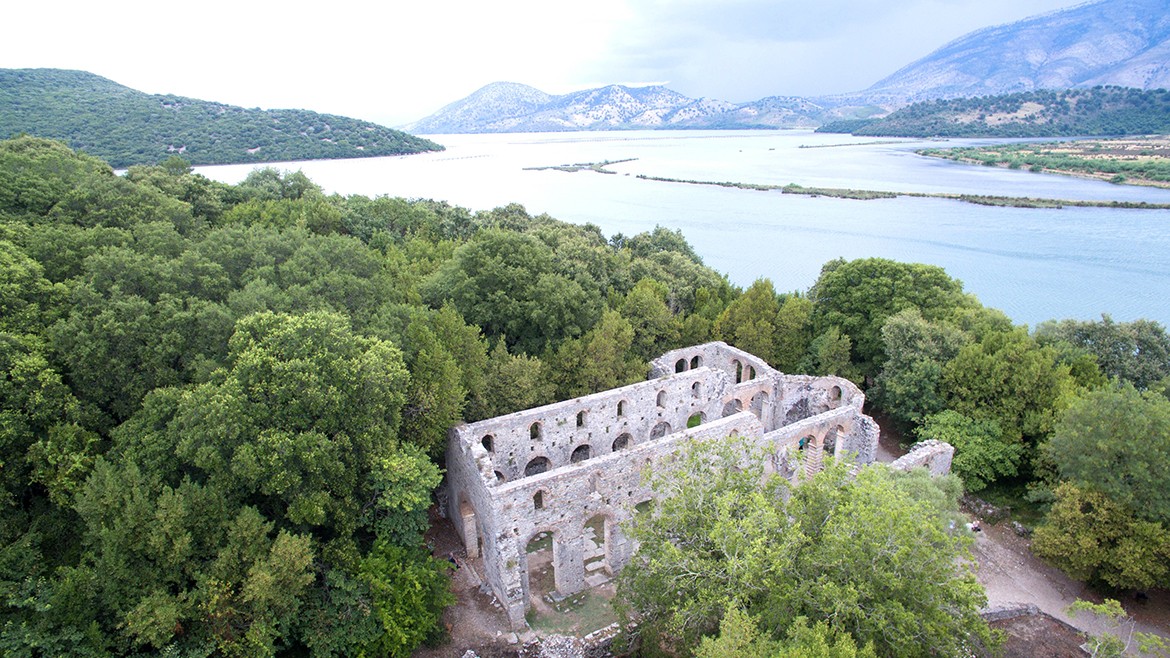
View from the Great Basilica in Butrint World Heriate Site
Origins & City
Butrint (ancient name Buthrotum) was an important settlement in Antiquity. The fortifications and the monuments of this city bear testimony to the different stages of their construction, while the archaeological remains represent each period of the city development and history up to the turn of the 19th century.
Archaeological excavations have revealed that the earliest settlement at Butrint was probably limited to the acropolis hill: a small nucleus of the Late Bronze Age may have occupied the saddle and the eastern hill peak. The early settlement was probably walled and might have been associated with a shrine that flourished in later centuries.
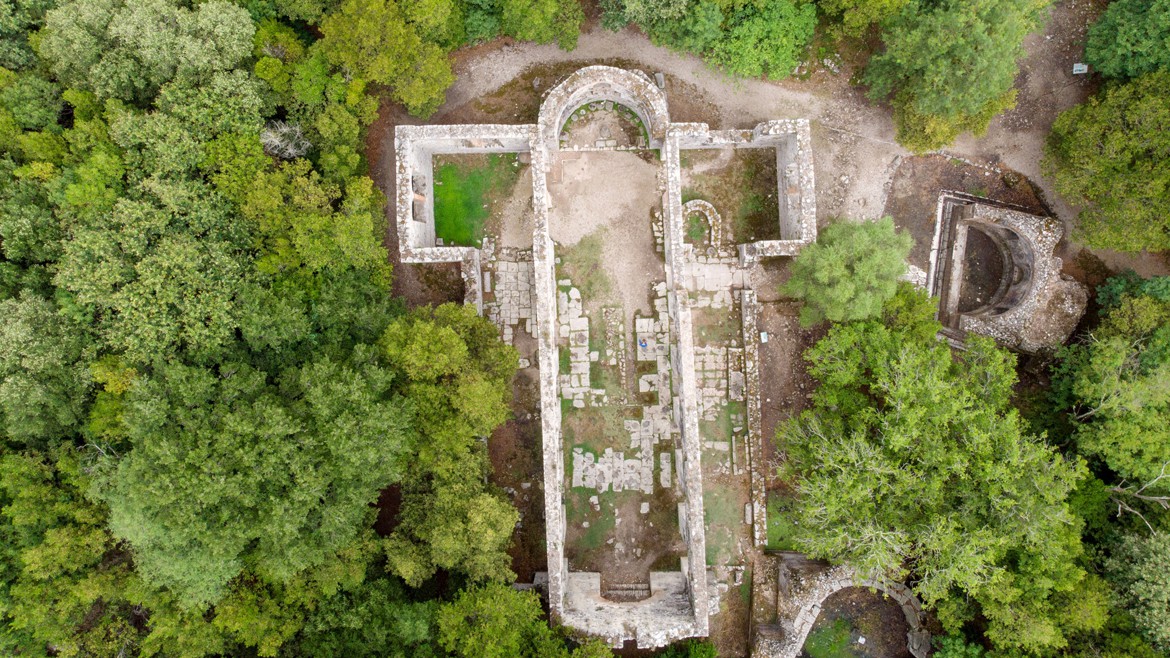
Aerial view of the Great Basilica in Burtint
Corcyrean, Chaonian and Prasaebean Butrint (7th – 2nd century BC)
Situated on the furthermost edge of Ksamil Peninsula, Butrint was a privileged centre in Antiquity occupying a highly favourable position close to one of the most important sea routes, which provided a major stimulus for the economic and social development of the city. The city was continuously inhabited since prehistoric times and it became a site of a Greek colony. It was established as a fortified centre in the 7th century BC. It was first recorded by the Greek geographer Hecataeus of Miletus in the 6th century BC.
At that time Butrint was a small acropolis under the control of Corcyra (Corfu), which emerged as an emporion, serving the commercial relations of the local population and exploiting the lake fisheries. The situation of the Corcyrean emporium of Butrint changed radically at the turn of the 4th century BC, when Molossian king Alketas invaded the coast opposite Corcyra, including Chaonia. Around 380 BC, Butrint was transformed from an emporion into a fortified city with the old fortification conserved as an acropolis. During the last decades of the 4th century BC the chief tribes of Epirus (Molossians, Thesprotians and Chaonians) created the Symachy of Epirus, a military alliance run by the Aeachidian kings, which rendered the region widely autonomous. Phoenice became the Chaonian capital city and Butrint the centre of Prasaebes Koinon, one of the autonomous subdivisions of the Chaonians.
In 231 BC, the monarchy of Epirus was brought down and the region was declared a republic known as Epirotes’ Koinon. The Prasaebes Koinon, with Butrint as its centre, remained an autonomous territory in the Epirotes’ Koinon until 167 BC.
During the Hellenistic Period, Butrint reached its zenith and was enhanced with new buildings: a theatre, an agora and a circuit of defensive walls encircling the acropolis hill and the shrine of Asclepius on its southern slope. However, the entire region was soon drawn into the increasingly violent contest between the rising power of the Roman Republic and the established kingdom of Macedonia.
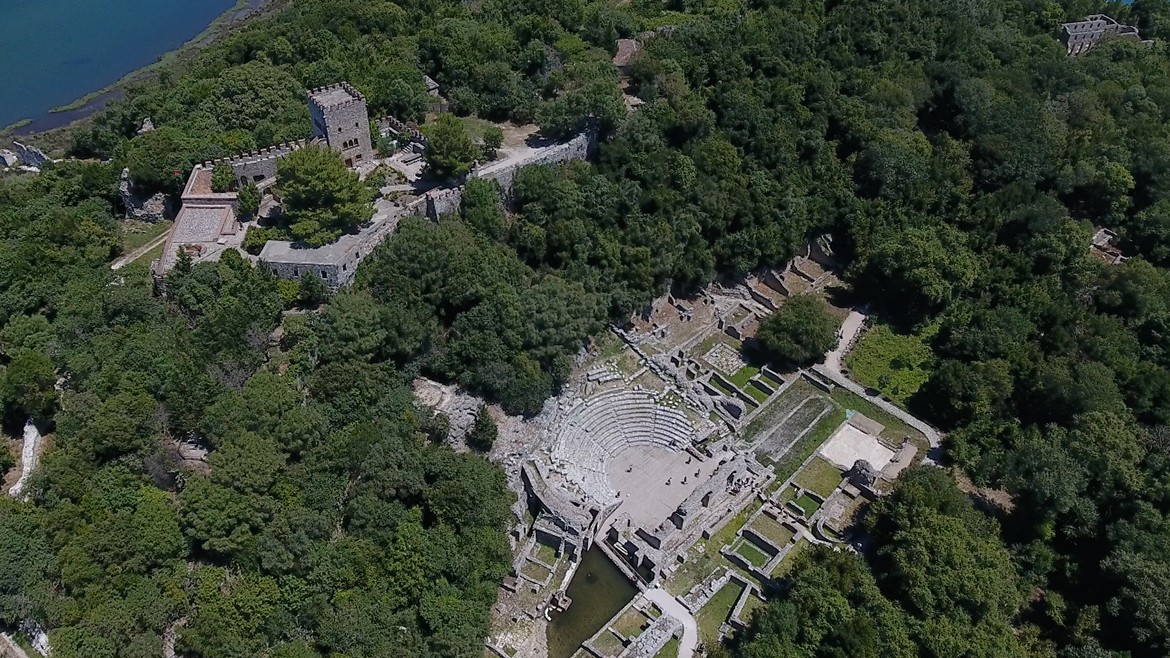
Butrint from the air
Roman Period
By the early second century BC, Rome had secured control of Corfu and dominated Chaonia in 168 BC, when Macedonia was finally defeated, and its territory ultimately made into a Roman province. Thereafter, Butrint was increasingly entangled in Roman politics. In 44 BC, after his victory over Pompey, Caesar attempted to establish a colony at Butrint, a plan which came to fruition later, around 30 BC, under Augustus. From this time on, the construction of new buildings and facilities began: a forum, an aqueduct and bathhouses were planned. By mid–3rd century AD, later documentary records associate the city with the miracle of St. Therinus. During that century, Butrint started to decline and an earthquake destroyed a large part of the city. However, the settlement survived into late Antiquity, while the city underwent significant changes, experiencing a period of expansion and flourishing.
Late Antiquity and Byzantine Period
In the 5th century AD Butrint emerges as an early Episcopal centre. The early medieval city was clearly a much – reduced entity, but not entirely abandoned; the settlement probably shrank as a hub around the foot of the acropolis and the area around the basilica. In the 9th and 10th centuries, Butrint formed an outpost of the Byzantine Empire and emerged as a Bishopric Seat under the metropolis of Nicopolis. The city walls were reconstructed and a new wall around the shoreline of the Channel was built. An Episcopal Palace, the baptistery and the basilica constitute testimonies of this period.
In 1081 Butrint was seized by the Normans, under Robert Guiscard and his sons. Later, their successors, the Angevins, rulers of the Despotate of Epirus used the city and other coastal cities as bases for attacks against the Byzantine Empire, until 1386, when Butrint was purchased by the Republic of Venice.
17th – 19th century
In mid–17th century the city was occupied by the Ottomans, which resulted in a rapid decline of economic activity. In 1660 the Venetians captured Butrint again and built a tower to control the lake fisheries. The Venetian rule lasted until the collapse of Serenissima in 1798 and a short period of French possession of the city followed. In 1799, the Albanian Ottoman governor Ali Pasha conquered Butrint, which became part of the Ottoman Empire. Ali Pasha constructed a new castle at the mouth of the Channel and controlled Butrint until his assassination in 1822.
References:
Neritan Ceka, Fortifikimi antik i Butrotit dhe i territorit të Prasaibëve, Monumentet, 12, 1976.
Gjerak Karaiskaj, Butrinti dhe fortifikimet e tij, Tiranë, 1983.
Astrit Nanaj, Butroti protourban, Iliria, 2, 1985
Luigi M. Ugolini, Butrinti. Miti i Eneas (translated from Italian by Zef Simoni), Instituti Italian i Kulturës, Tiranë, 2000.
Neritan Ceka, Buthrotum (translated from Albanian by Pranvera Xhelo), Migjeni, Tirana, 2002.
Neritan Ceka, Archaeological Treasures from Albania, Volume II, Migjeni, Tirana, 2012.
Ancient monuments
The Agora
The centre of the city public life where important buildings, such as the theatre, the temple of Asclepius, the prytaneion, the stoa, etc., were constructed.
The theatre
The theatre dates to the 3rd century BC. The massively enlargement of the cavea/koilon and the reconstruction of the stage was undertaken by the Romans, at the end of the 2nd century AD and it was be used until the early 4th century AD. A large number of sculptures, probably decorating the auditorium or adjacent spaces, were unearthed in the stage area, among which a fine portrait of Augustus, his wife Livia, and the great general Marcus Vipsanius Agrippa, as well as the sculpture that came to be known as the “Goddess of Butrint”, which, in fact, depicts the god Apollo, etc. The theatre was abandoned in the early 4th century AD.
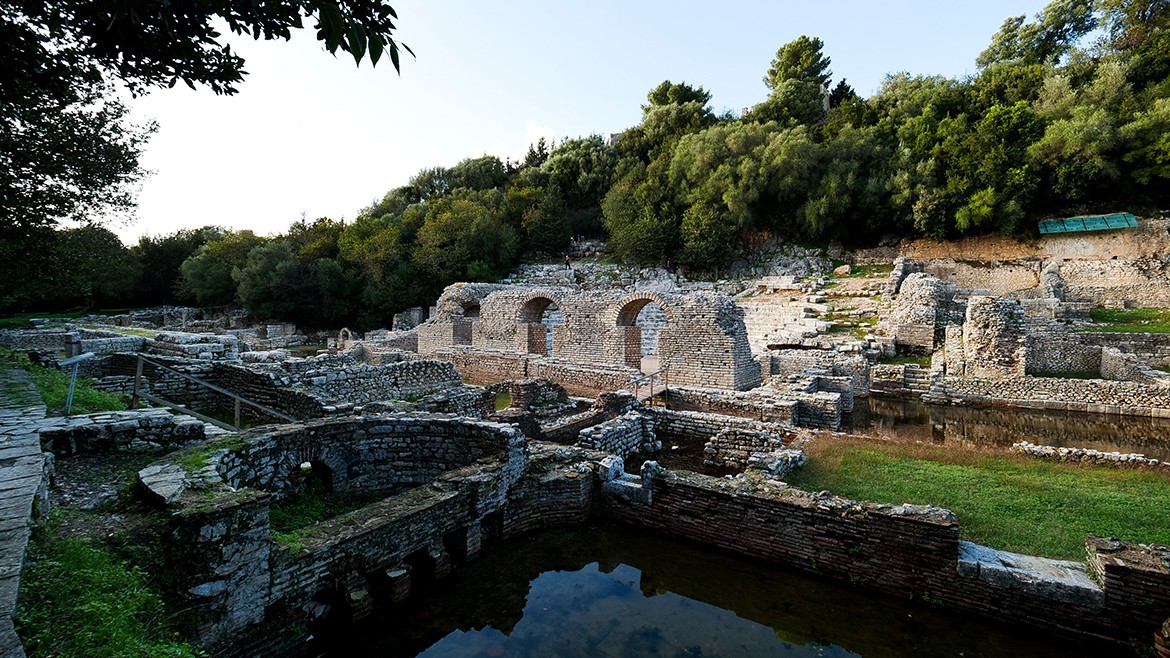
The theatre in Butrint
The stoa
The remains of a Hellenistic stoa are located at the foot of the acropolis hill. This structure was probably part of the sanctuary of Asclepius. A very degraded panel of painted plaster, with a series of saints and prophets, visible above the structure, is all that remains from the 13th century Byzantine church demolished during the interwar excavations.
The shrine of Asclepius
This was built in the 2nd century AD. An inscription dedicated by the priest of Asclepius, testifies that the temple is a shrine to Asclepius, god of medicine.
The prytaneion
This is the seat of the strategus. The monument was excavated by the well - known Albanian archaeologist Dhimosten Budina who dated its earliest phase to the 3rd century BC, linking its construction to the period of autonomy of the Prasaebean Koinon. In the 1st century AD the building was subjected to transformations.
The shrine of Minerva
This building might have been a shrine to Minerva; it was built over an earlier 3d century BC construction. A later rebuilding phase resulted in a three-roomed structure of shrines, as confirmed by an inscription suggesting that the complex may have been dedicated to Minerva.
The Gymnasium
The so-called “Gymnasium” is an enigmatic complex surrounding a central Roman brick fountain with mosaics depicting water birds and a kantharos bowl above/crowning the niches. It constitutes a 2nd century AD public building that was in use until Late Antiquity.
The Roman bathhouse close to Vivari Channel
Dating back to the 2nd century BC, it was continuously used until the 3rd century AD. The remains of a heated room with the underfloor hypocaust heating system, as well as a square chamber, probably the apodyterium, or dressing room, with a geometric mosaic pavement, are some of the elements preserved from this monument.
The Venetian Tower
The Venetian Tower is a two – storey building of 15th – 16th century, with its main purpose being to survey the fisheries of Butrint.
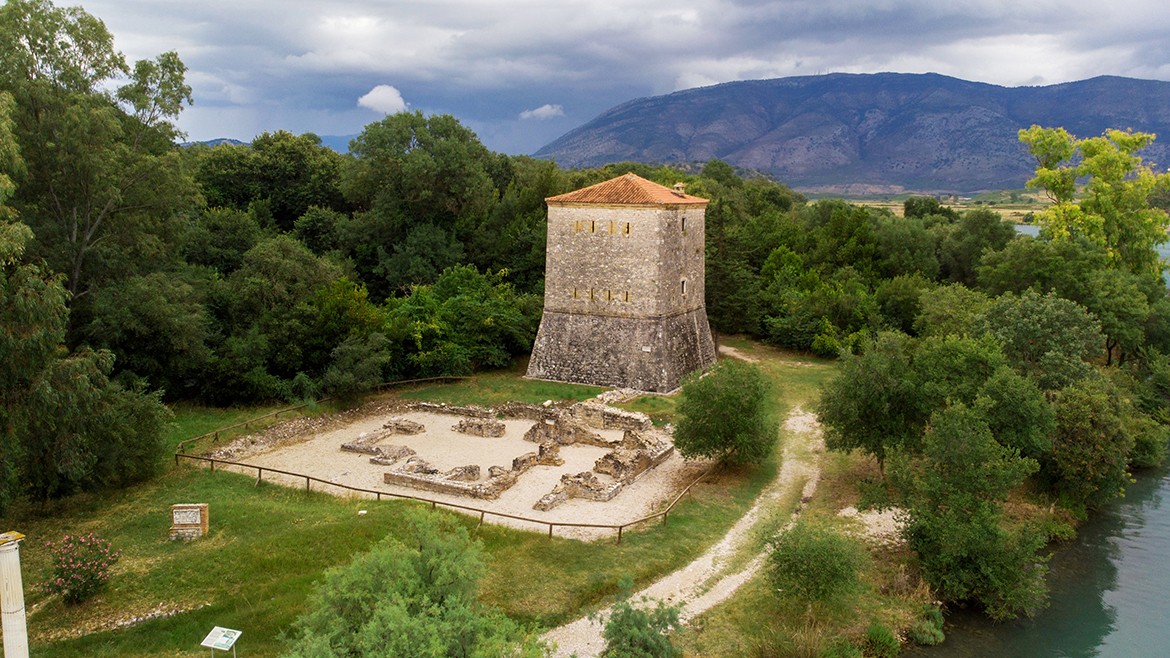
The Venetian tower in Butrint
The Lower city
The Triconch Palace
The building complex lies on the shore of the Vivari Channel. It is one of the numerous elaborate residences of the later Roman town, probably the dwelling of one of Butrint’s leading citizens. At the time of its initial construction (2nd and 3rd centuries AD) it comprised a modest residence with wings and a peristyle/collonade. Each room contains remarkable floor mosaics composed of interlocking decorative bands and panels depicting theatre masks, which indicates the high social status of the owners. Around the second half of the 5th century AD, when Buthrotum became an Episcopal centre, there was a massive expansion of the Triconch. Archaeological excavations show that the Episcopal complex was destroyed in the second half of the 6th century, probably due to the Slavic invasion.
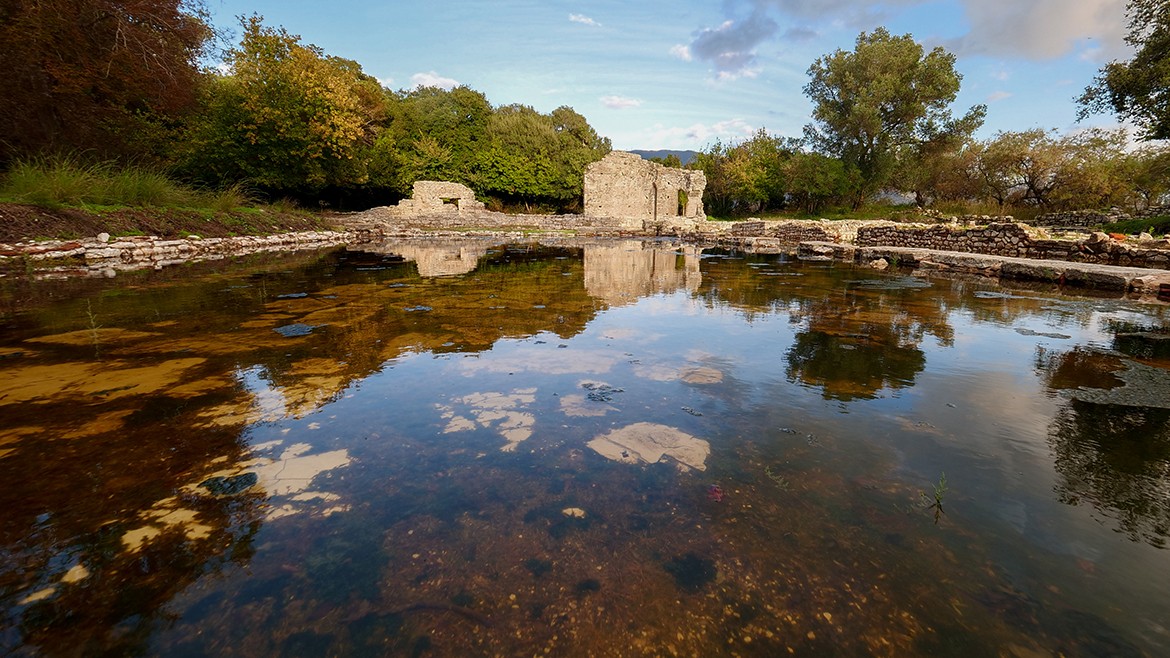
The triconch palace in Butrint
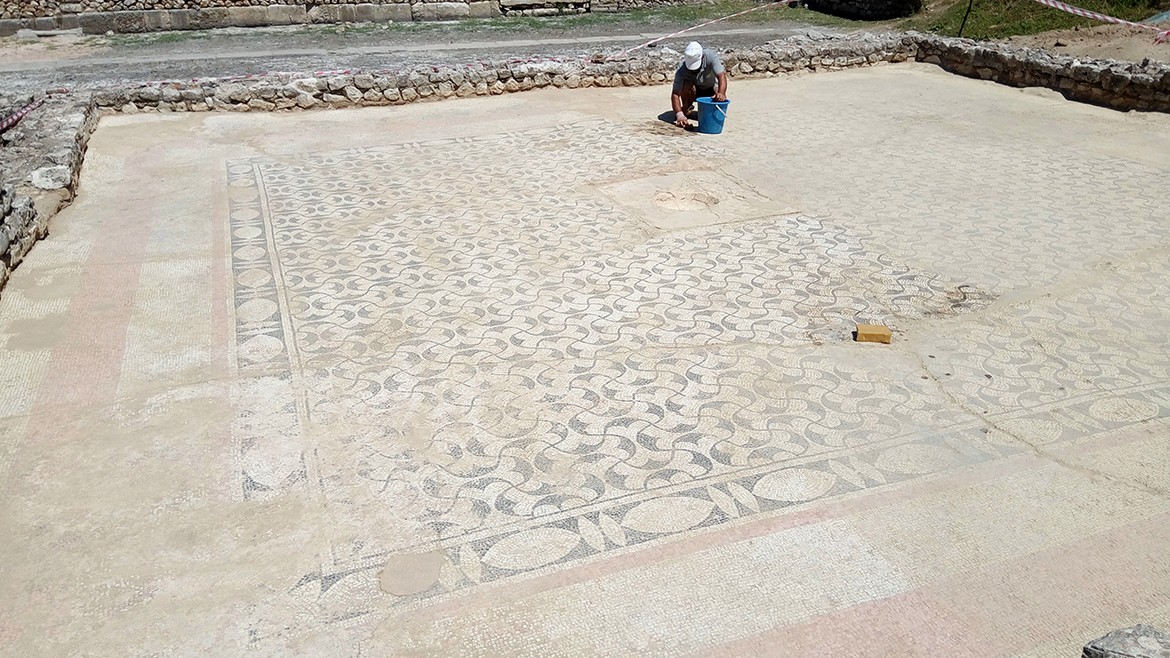
Mosaic floor in Butint
The baptistery
This is one of Butrint’s key monuments and one of the most elaborate baptisteries of its time in the Balkans. Its construction can be dated to ca. 550 – 575 AD based on the stylistic analysis of the great mosaic pavement. The complex was built over the remains of a Roman bathhouse.
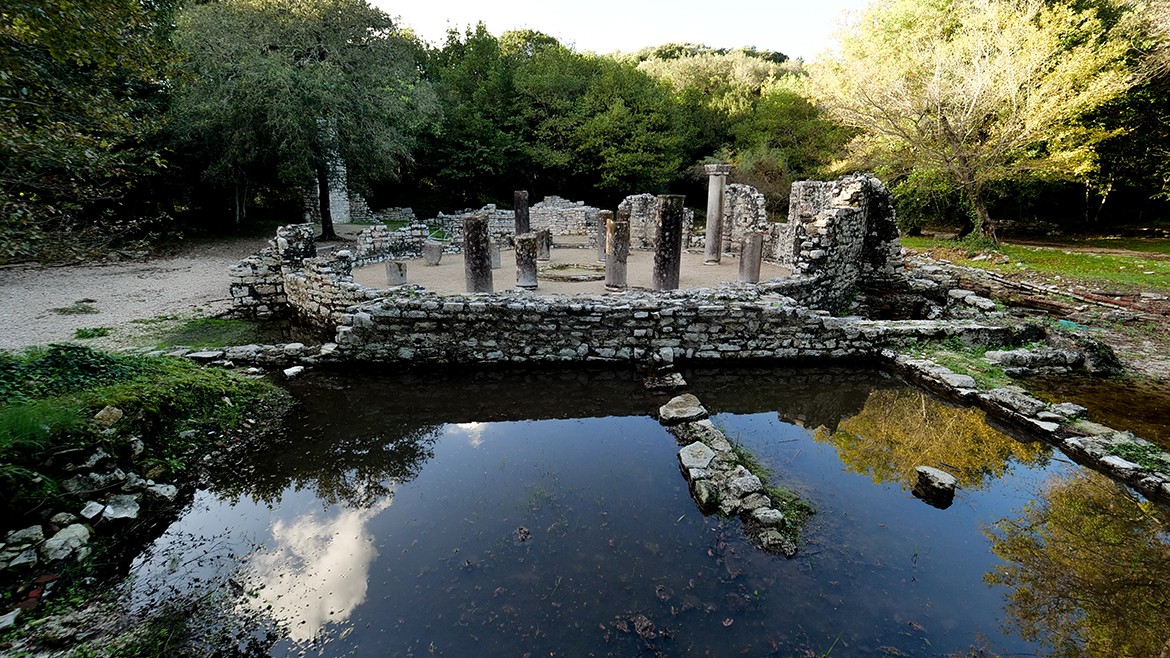
The Baptistery in Butrint
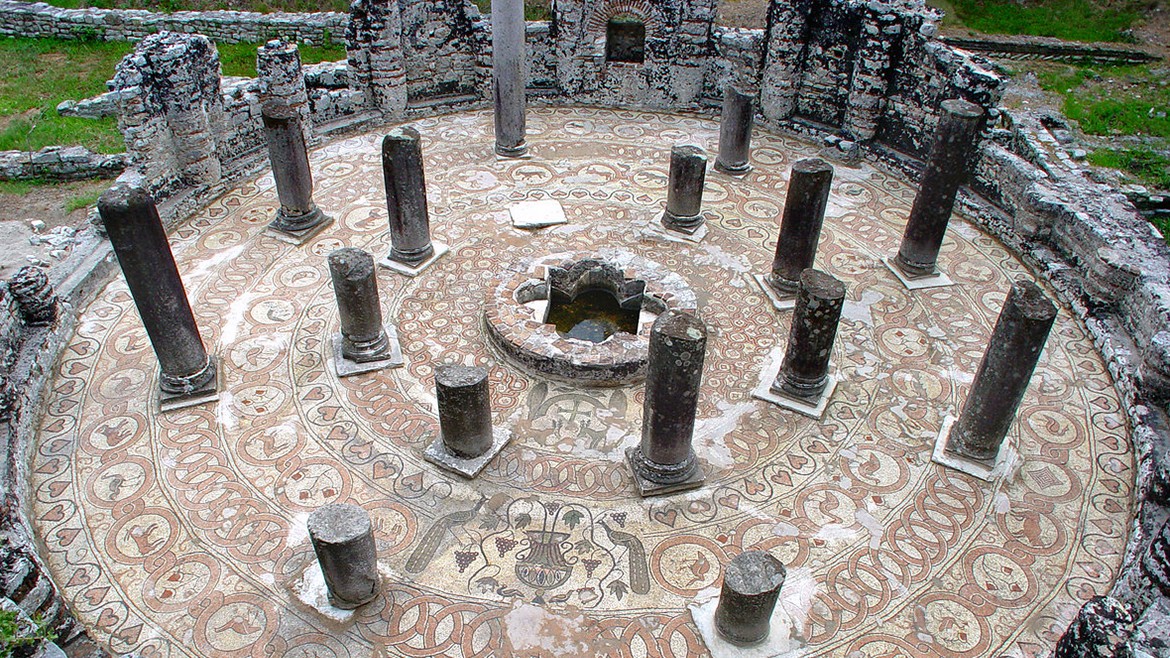
Mosaic from the Baptistery in Butrint

Detail of the mosaic floor from the Baptistery in Butrint
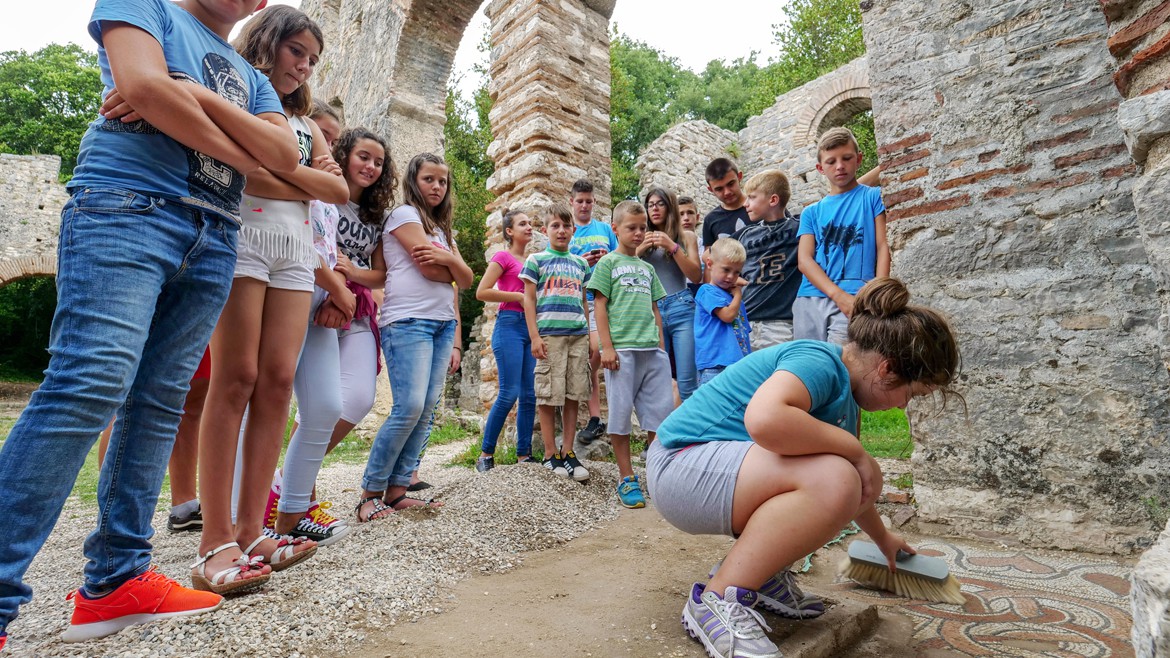
Education through culture at Butrint
The Great Basilica
The church survives almost up to roof height, making it one of the best-preserved late antiquity basilicas in the region. It was built in the first half of the 6th century AD. Following a period of dilapidation, the church was modified between the 9th and 13th centuries AD, during the period of the Despotate of Epirus. The monument appears to have been abandoned in the 18th century.
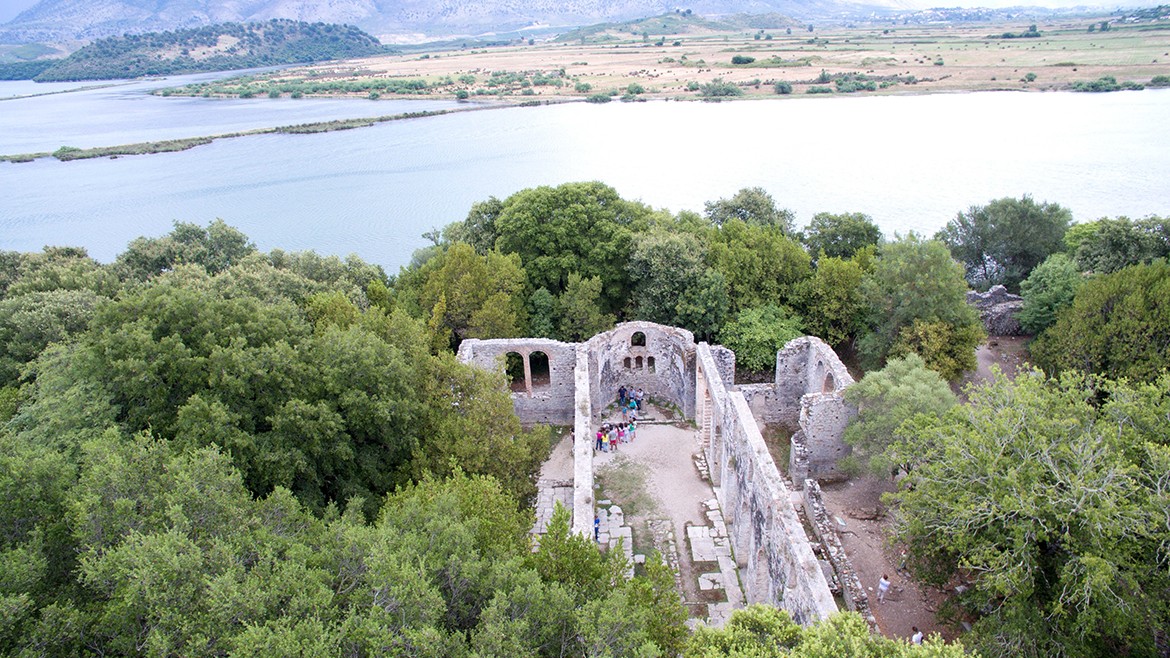
The Great Basilica in Butrint
The Scaean Gate
The so-called “Lake Gate” was discovered and excavated by the Italian Archaeological Mission in the 1920s and ‘30s, and has been interpreted as evidence confirming the Virgilian legend. The excavator, Luigi Maria Ugolini, named it the “Scaean Gate” after the great portal of Troy. The gate was used uninterruptedly with substantial modifications throughout Antiquity.
The Lion Gate
It was named after the impressive carving of a lion attacking a bull that decorates the great archaic style lintel of the gate. The same lintel was reused during the reconstruction of the same gate at a later date, while the original gateway was a corbelled archway of the Hellenistic period, larger than the Lake Gate.
The Well of Junia Rufina
The well has a natural grotto-like appearance that must have enhanced its appeal as a sacred well. In the Roman period it was elaboratedly decorated with a wellhead, and on the stone balustrade there was a carved inscription saying: “Junia Rufina friend of the nymphs [built this]”.Besides its practical function, the well was linked to the cult of the nymphs as protectors of water sources. In the 5th or 6th century AD the pagan well was Christianised as shown by a painting on its back wall.
The acropolis
Uphill from the modern castle excavations have exposed Roman and later remain including sections of the substantial medieval acropolis walls, with towers and gun embrasures. While Bronze Age pottery has been recovered from these excavations, and some possible early structures have been found, there is little significant evidence of a substantial Bronze or Early Iron Age presence here. The first settlement on the acropolis hill may have been nothing more than a small fortified refuge focused on the eastern summit. A temple or sanctuary probably existed here in classical antiquity and was extensively rebuilt by the Romans. This spot is currently occupied by the remains of a late antique church.
Natural Significance
Butrint represents a unique blend of cultural and natural landscapes that illustrates the interaction between man and nature over three millennia. The result is a magical landscape rich in archaeological remains, of exceptional biodiversity, with diverse natural, semi-natural and artificial habitats. At its centre lies the main archaeological site of Butrint. The site, surrounded by the waters of the Vivari Channel and Lake Butrinti and hidden by woodland, is a magical place. The unique combination of archaeological finds and natural beauty creates a special atmosphere unique in the Mediterranean. Beyond the main site other monuments illustrate over 3,000 years of human presence.
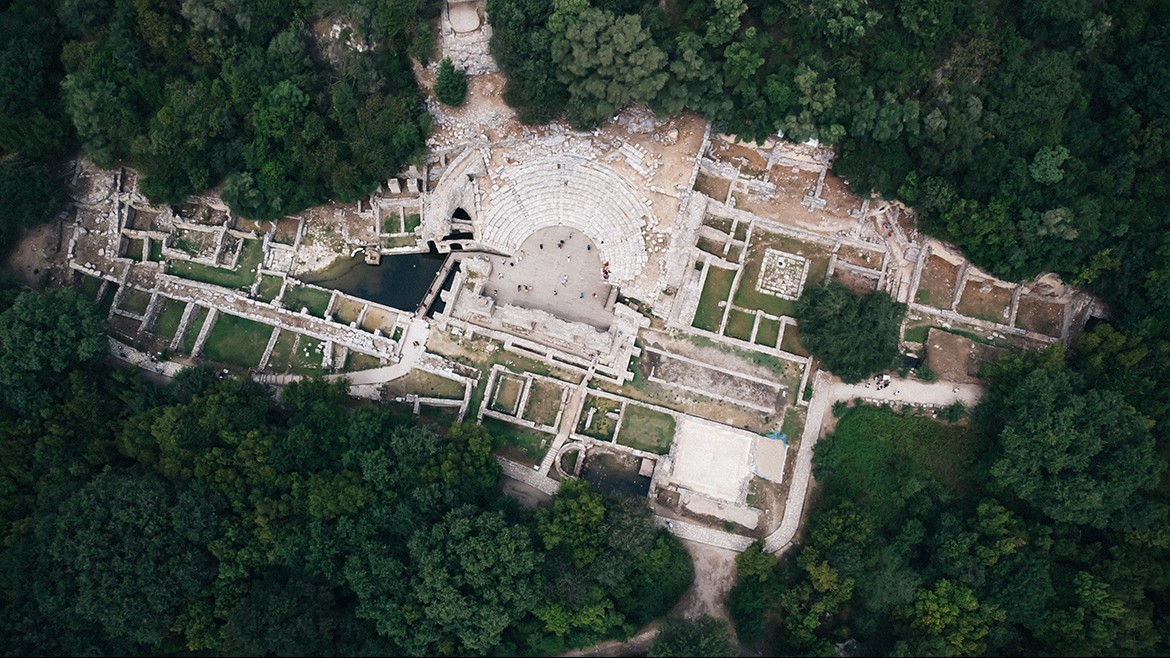
Butrint from the air
The Butrinti site is characterised by a very diverse and dynamic hydrological system, composed of rivers (the Pavllo, the Bistrica and the Kalasa), lakes (Butrinti and Bufi), water reservoirs, estuaries and coastal waters, seasonally or temporary wetlands (such as those west of Vrina).
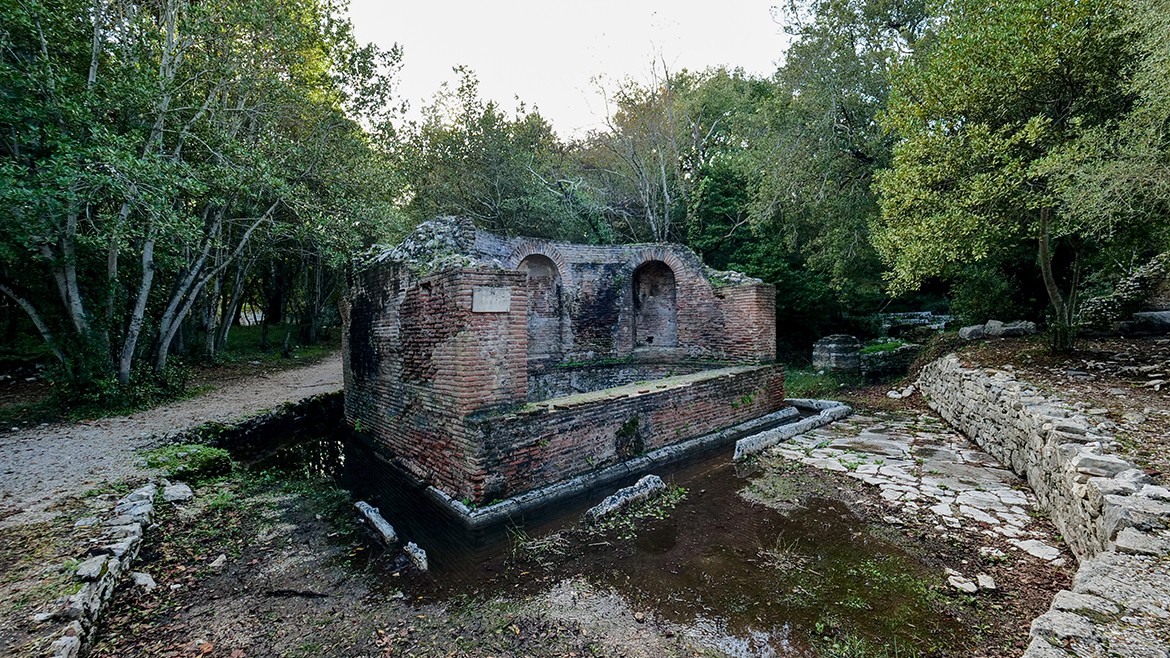
Numphaeum at Butrint
In 1981 the Butrinti area was declared a site of nature conservation interest, and the Butrinti forest was designated as a protected forest. Later on, in 1999, the Butrinti was proclaimed a National (Archeological) Park and in 2002 as a Ramsar Wetland Site, extending over a radius of at 25km2 (archaeological site) and 135km2 (Ramsar site), respectively. In November 2005, by a Decision of the Cabinet of Ministers, Butrint national park was further enlarged over a radius of 86km2.
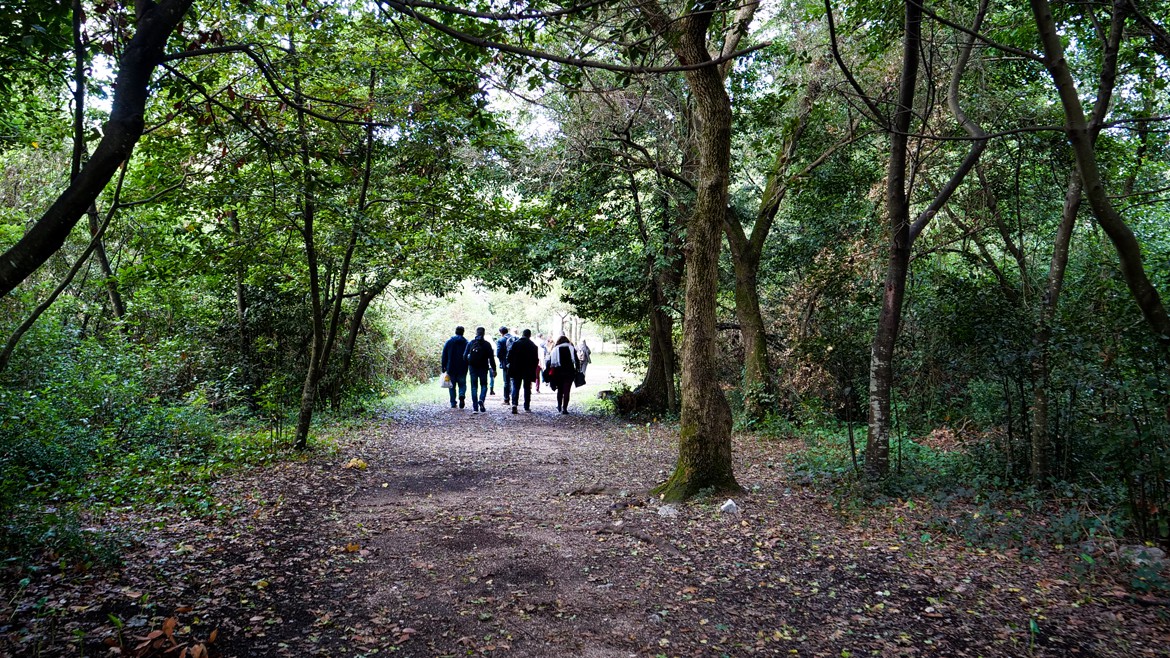
Nature in ancient city Butrint
Habitats
Butrinti includes a set of different habitats, artificial, semi-natural and natural, ranging from wetlands in the West to mountainous territories in the East. Each habitat is important in terms of species diversity and abundance. Butrinti has the highest number of species of amphibians and reptiles ever recorded at an Albanian site. Besides the high number of species, it is also the only site in Albania that supports the Epirote Frog Rana epeirotica and the Marginated Tortoise Testudo marginata, the Sand Boa Eryx jaculus and the Balkan Wall Lizard Podarcis taurica jonica. Littoral waters of the BNP area are visited by rare and globally threatened sea turtles, such as Loggerhead Caretta caretta (EN) and Leatherback Dermochelys coriacea (CR).
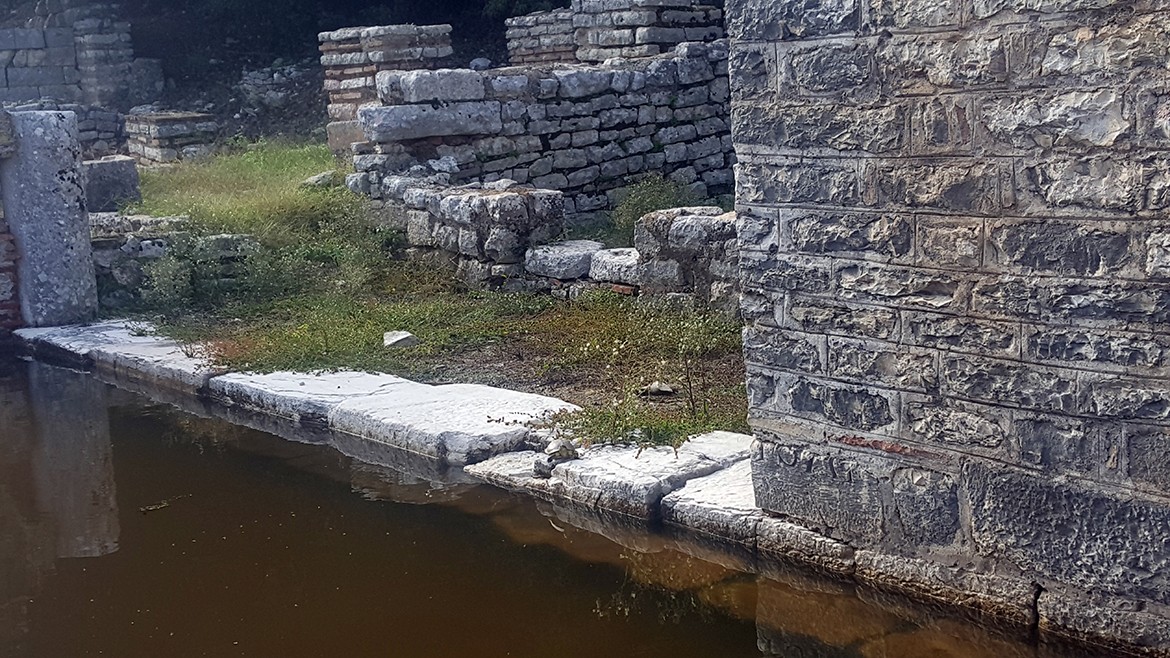
Fauna in Butrint
Compared to other wetland areas in Albania, Butrint also registers the highest number of bird species ever recorded at an Albanian site. The complex is also one of the most diverse sites for mammals in Albania. It is the only site where sightings of the monk seal (Monachus monachus) have been reported in the country so far.
The combination of archaeological finds and natural beauty makes Butrinti a place of a special spirit and authenticity. The mixed oak woodland habitat dominated by Quercus ilex, albeit fragmented, is a habitat that has largely disappeared in Albania. This makes the site to be a typical and unique place in the country. Littoral benthic communities, especially those along Cape Stillo, dominated by large sea grass meadows of Posidonia oceanica, are very well developed and preserved, rendering this site a candidate site to become a Marine Park in Albania.
The national and regional institutions competent for the protection of significant natural sites and the development of tourism are the Ministry for Tourism and the Environment and the National Agency for Protected Areas, which operates in the region through the Vlorë, Regional Agency for Protected Areas.
Biodiversity
Butrint National Park stands out for its high biodiversity: there are 27 types of habitats of Annex I of EC Habitat Directive, of which 5 are priority habitats for Europe. Butrint supports plants and/or animal species important for maintaining the biological diversity of its biogeographic region. The site shelters a high percentage of the biodiversity in Albania. Its role is particularly important for certain groups of species, such as amphibians, reptiles, birds, and mammals.
The area is one of the most important coastal complexes of Albania, with nearly 17% of the country’s species wealth. Regarding the diversity of its flora and fauna, Butrinti definitely presents the highest figures ever registered in an Albanian wetland complex.
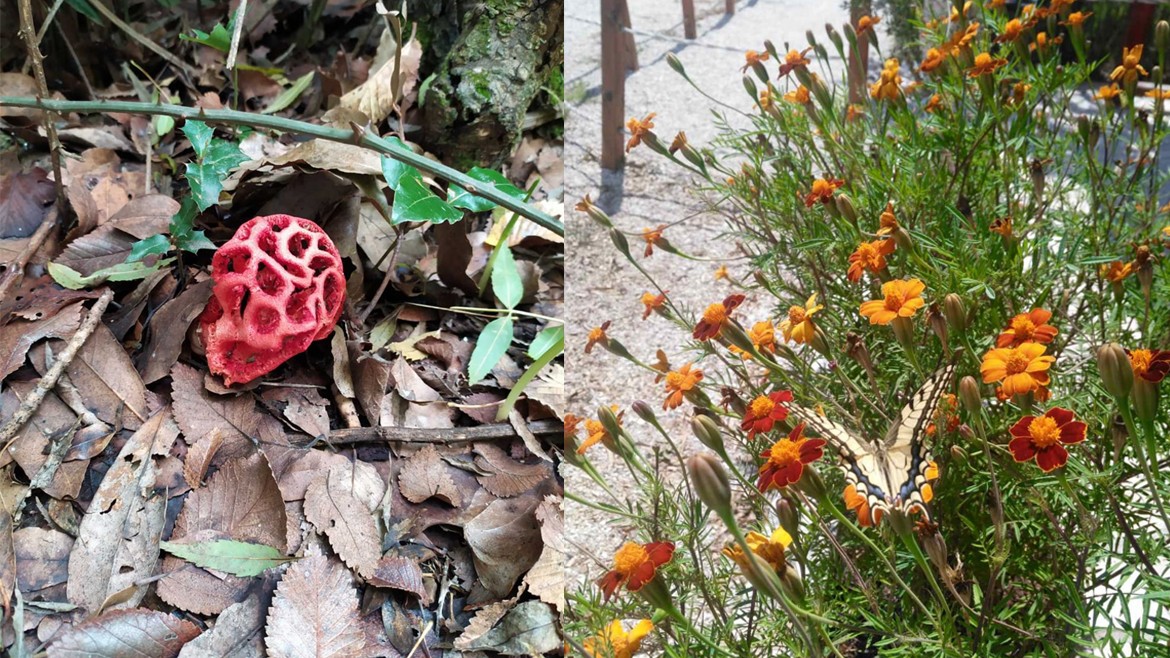
Flora and fauna in Butrint
As a wetland complex designated as a Ramsar Site, birds are considered an important element of the Ecosystem. The high number of bird species is a good indication of what the area offers to avian populations. Its overall ecological status is also confirmed, since birds are often referred to as ‘bioindicators’. On the other hand, nearly 10% of the species are reported as extinct. 36% of the species have an unfavourable local conservation status of either exceedingly rare or rare. The extinction of 24 bird species is strongly related to the loss of their feeding and nesting habitats due to hydrological changes.
If you want to know more information about Butrint check our website below
www.butrint.al
Butrint offers an exceptional cultural landscape; its special atmosphere is created through the combination of archaeological finds, monuments and Mediterranean natural beauty. In the framework of the MoNa Project, this World Heritage Site has been selected as a pilot site for realizing and implementing the following main outputs in the framework of a Holistic Approach:
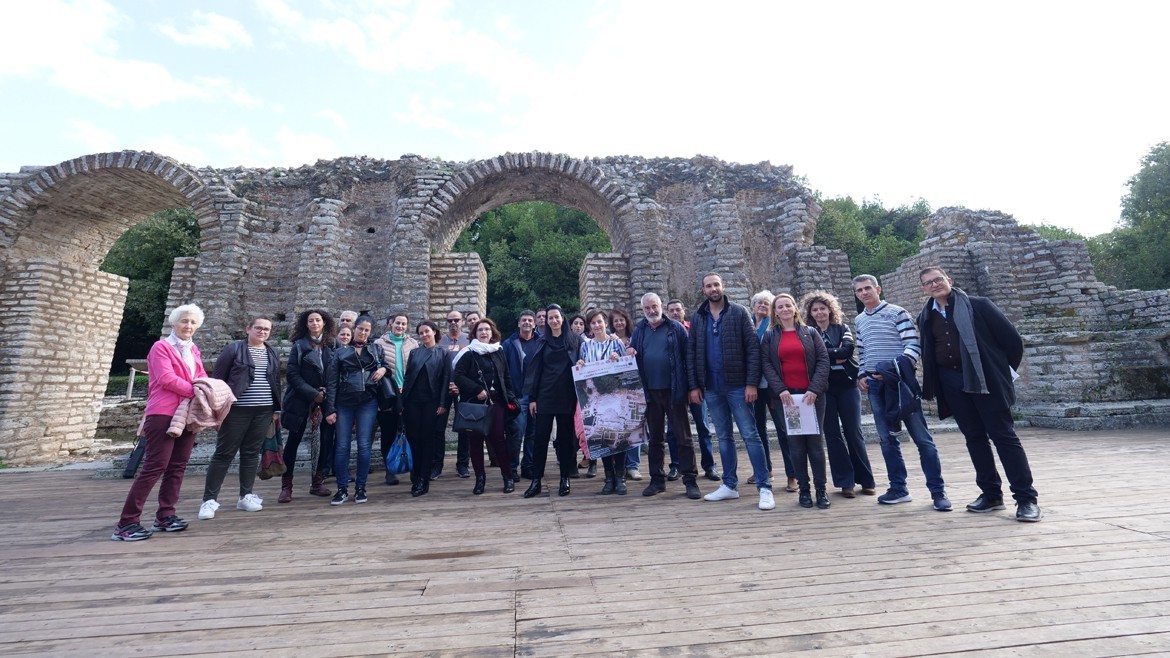
The Mo.Na team at Butrint